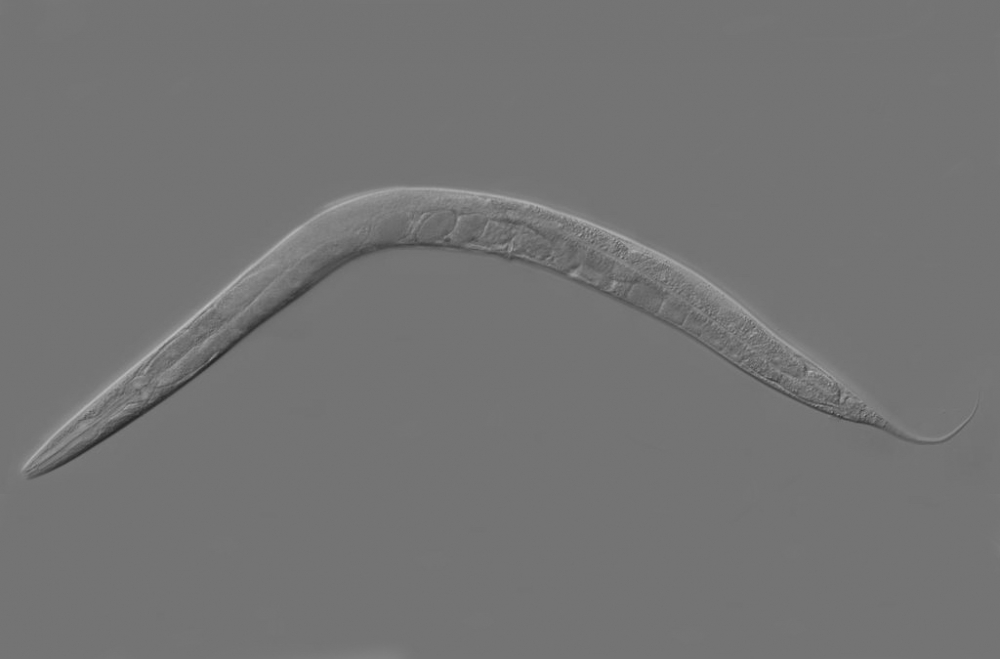[ad_1]
Caenorhabditis elegans.Credit: Wikipedia
Our bodies are home to several types of bacteria that help maintain our health and wellbeing. Therefore, altering the activity of failed genes by manipulating these good bacteria to reduce or activate them is a promising approach to improving health and fighting disease. ..
In a study published in a journal Nature communicationResearchers at the University of Texas A&M have developed a sophisticated, programmable gene silencing system that could influence future therapies.
With chemical triggers, researchers can use bacteria developed in the laboratory E. coli (((E. coli) Can be induced to produce a gene product that suppresses certain traits Caenorhabditis elegans (((C. Elegance), Roundworm that consumes this variety as food. Similarly, researchers will say that in the future Symbiotic bacteria Within Human microbiome It can be designed to capture, record, and deliver treatments to improve health and wellbeing.
“The continued success of microbiota-based therapies depends on the development of reliable media for the delivery of therapeutics,” said Dr. Qing Sun, Assistant Professor in the Department of Chemical Engineering, Artie McFerrin. “Here I fine-tuned with bacteria. Gene expression In another organism, this is a proof-of-concept that bacteria that live in harmony with humans can be designed to regulate. Human physiology Treat the disease. â€
In addition to genes that are tightly bound to chromosomes, bacteria and certain other microorganisms have other shorter circular strands of DNA called plasmids. Not only can plasmids replicate, they also carry far fewer genes than their chromosomal counterparts. These properties make it easier to manipulate the plasmid with genetic tools. In particular, stretches of DNA from other organisms known as transgenes can be inserted into bacterial plasmids.
In addition, replication of the plasmid produces multiple copies of the transgene. For example, when a human gene to make insulin is inserted PlasmidThen, when the bacterium replicates, the copy of the plasmid increases, which leads to the production of the insulin gene. Therefore, when these genes are expressed, more insulin is produced. Alternatively, the plasmid can be extracted from the bacterium and the transgene inserted into the genome of another cell to be used as a vehicle to alter the plasma of those cells.
Researchers have found that while these types of genetic manipulation are common in mammalian cells and other simple microorganisms, they are often difficult to coordinate in more complex multicellular organisms. To overcome these hurdles, Sun and her team chose a symbiotic bacteria-host pair. In particular, they chose ground-dwelling worms, C. elegans, It eats E. coli..
First they put the transgene in E. coliPlasmids that can disrupt genetically engineered strains of C. elegans, It has the ability to glow fluorescent green. The chemical was then used to cause the plasmid to express the green fluorescence suppressor gene. After all, they have bacteria C. Elegance And only that C. Elegance Consumed it E. coli The transgene has stopped glowing green.
Sun and her team also programmed E. coli Produces gene products with various “AND†and “OR†logic gates. Simply put Gene product Can only be generated selectively by a combination of two or more actions geneWhen any gene is expressed, as in a mathematical “AND” operation or as in a mathematical “OR” operation. Again, the researchers used chemical triggers to initiate an “AND†or “OR†combination of gene expression. E. coli Spasmodic behavior must be silenced C. Elegance After the worm eats the bacteria.
Sun said its bacteria-based gene silencing systems can easily be extended to other biological systems for pest control, plant growth promotion and animal disease diagnosis.
“Bacteria are symbiotic with many species and affect the metabolism, immunity and behavior of the host,” says Sun. “Here we have the symbiosis between bacteria And relatively complex organisms for developing programmable genetic tools that can have a positive impact on the host’s physiology. â€
Baizhen Gao from the Department of Chemical Engineering is the lead author of this study.
Baizhen Gao et al., Programming gene expression in multicellular organisms for physiological regulation by manipulated bacteria, Nature communication (2021). DOI: 10.1038 / s41467-021-22894-7
Quote: Genetically modified good bacteria are diseases that were received on August 24, 2021 from https://phys.org/news/2021-08-genetic-gute-bacteria-aid-combating.html (8 2021) (March 24 )
This document is subject to copyright. No part may be reproduced without written permission except in fair transaction for personal investigation or research. The content is provided for informational purposes only.
[ad_2]

